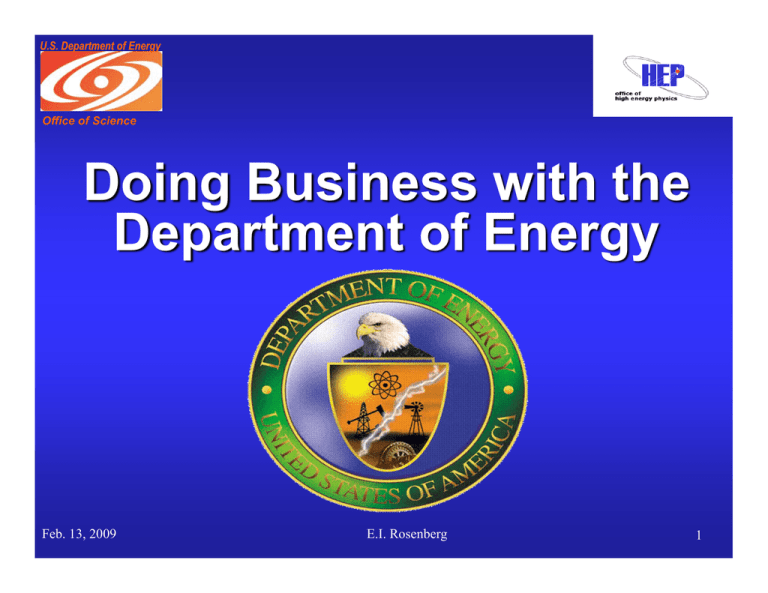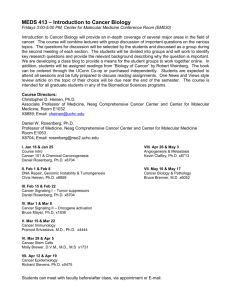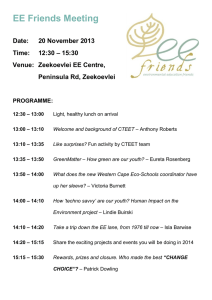Doing Business with the Department of Energy Feb. 13, 2009 E.I. Rosenberg
advertisement

U.S. Department of Energy Office of Science Doing Business with the Department of Energy Feb. 13, 2009 E.I. Rosenberg 1 U.S. Department of Energy Outline Office of Science Who am I? What is the Dept of Energy? What is the Office of Science? How do you get an Office of Science Research Grant? Other programs you should know about Interacting with the OS Laboratories Questions Feb. 13, 2009 E.I. Rosenberg 2 U.S. Department of Energy Who am I ? http://www.public.iastate.edu/~redmount Office of Science Professor of Physics and Past-chair of the Department of Physics and Astronomy at Iowa State University Was Principal Investigator for over 20 years on a DOE grant at Iowa State Was a Program Director at the Ames Laboratory, U.S.D.O.E. Currently on an Interagency Personnel Assignment to the Office of High-Energy Physics, Office of Science at the Dept of Energy Managing about 20 university grants Feb. 13, 2009 E.I. Rosenberg 3 U.S. Department of Energy Evolution of the Department of Energy Office of Science 1. Manhattan Project to the A.E.C. Manhattan Project began with Einstein’s August 1939 letter to FDR on the potential of nuclear fission to create a powerful weapon Top Secret World War II Project to Develop such weapons After the war and the destruction of Hiroshima and Nagasaki, the US Nuclear program was formalized and made public. Atomic Energy Commission established with the Atomic Energy Act of 1946 Feb. 13, 2009 E.I. Rosenberg 4 U.S. Department of Energy Evolution of DOE cont’ d Office of Science 2. A.E.C. to ERDA/NRC In 1953, In the midst of the Cold War, President Eisenhower delivered his famous “Atoms for Peace” Speech to the UN General Assembly calling for development of peaceful applications for nuclear technology. Atomic Energy Act of 1954 ended exclusive government use of atom. In 1957 the first large scale nuclear plant began operations in Shippingport, PA. 1974 Energy Reorganization Act split the Atomic Energy Commission into: Nuclear Regulatory Commission Energy Research and Development Administration Feb. 13, 2009 E.I. Rosenberg 5 U.S. Department of Energy Office of Science Evolution of DOE cont’ d 3. ERDA to DOE The NRC regulates commercial nuclear power plants and other uses of nuclear materials, such as in nuclear medicine, through licensing, inspection and enforcement of its requirements. 1977: The Department of Energy Organization Act, signed by Jimmy Carter, created and activated the Department of Energy we have today. Feb. 13, 2009 The DOE Mission advance the national, economic, and energy security of the United States promote scientific and technological innovation in support of that mission ensure the environmental cleanup of the national nuclear weapons complex E.I. Rosenberg 6 U.S. Department of Energy National Laboratories Office of Science Feb. 13, 2009 E.I. Rosenberg 7 U.S. Department of Energy Office of Science The Mission’s 5 Strategic Themes 1. Energy Security: Promoting America’s energy security through reliable, clean, and affordable energy 2. Nuclear Security: Ensuring America’s nuclear security 3. Scientific Discovery and Innovation: Strengthening U.S. scientific discovery, economic competitiveness, and improving quality of life through innovations in science and technology 4. Environmental Responsibility: Protecting the environment by providing a responsible resolution to the environmental legacy of nuclear weapons production 5. Management Excellence: Enabling the mission through sound management Feb. 13, 2009 E.I. Rosenberg 8 U.S. Department of Energy Science within DOE Office of Science Feb. 13, 2009 E.I. Rosenberg 9 U.S. Department of Energy Office of Science Office of Science Single largest supporter (more than 40%) of basic physical science research in the United States. Employs more than 30,000 scientists and engineers More than 40 Nobel Prize Winners Oversees nation’s research in High Energy Physics, Nuclear Physics, and Fusion Energy Research. Largest funder of materials and chemical sciences, Supports unique and vital parts of U.S. research in climate change geophysics genomics life sciences science education/workforce development Feb. 13, 2009 E.I. Rosenberg 10 U.S. Department of Energy Six Major Program Offices Office of Science Advanced Scientific Computing Research Research and application of advanced computational tools to support DOE research. Basic Energy Sciences Principal sponsor of fundamental research for the Nation in materials sciences and engineering, chemistry, geosciences, and bioscience as it relates to energy. Synchrotron light sources, neutron sources, electron microscopy, etc. Biological and Environmental Research Radiation and health. Human and environmental. Founder of the Human Genome Project, Fusion Energy Sciences advance plasma science and fusion science and technology High Energy Physics understand energy and matter at a fundamental level by investigating the elementary particles and the forces between them. Nuclear Physics to advance our knowledge of the properties and interactions of atomic nuclei and nuclear matter and the fundamental forces and particles of nature. Feb. 13, 2009 E.I. Rosenberg 11 U.S. Department of Energy Office of Science Department of Energy’s National Laboratories and Technology Centers Albany Research Center Ames Laboratory Argonne National Laboratory Brookhaven National Laboratory Environmental Measurements Laboratory Fermi National Accelerator Laboratory Idaho National Engineering Laboratory Lawrence Berkeley National Laboratory Lawrence Livermore National Laboratory Los Alamos National Laboratory National Energy Technology Laboratory National Petroleum Technology Office Feb. 13, 2009 National Renewable Energy Laboratory New Brunswick Laboratory Oak Ridge Institute for Science and Education Oak Ridge National Laboratory Pacific Northwest National Laboratory Princeton Plasma Physics Laboratory Radiological & Environmental Sciences Laboratory Sandia National Laboratory Savannah River Ecology Laboratory Savannah River National Laboratory SLAC National Accelerator Laboratory Thomas Jefferson National Accelerator Facility E.I. Rosenberg 12 U.S. Department of Energy Office of Science Students and Faculty can interact with the Office of Science in several ways The Office of Workforce Development for Teachers and Scientists The Office of Science National Laboratories The Office of The Office of Science laboratories have summer student programs, intern programs, workshops for undergraduate students, graduate students and faculty Grants to researchers at universities and colleges throughout the nation grants support postdoctoral students, graduate research assistants and undergraduate student helper Feb. 13, 2009 E.I. Rosenberg 13 U.S. Department of Energy Where do you start? http://www.sc.doe.gov/grants/grants.html Office of Science Colleges and universities, non-profit organizations, for-profit commercial organizations, state and local governments, and unaffiliated individuals may submit grant applications in response to Funding Opportunity Announcements (FOAs). Your college or university should have an office of research (or sponsored programs or contracts and grants) They have their own requirements. Submit an application via Grants.gov The Office of Science now requires all financial assistance applications be submitted through the Grants.gov website. Grants.gov is a Federal wide system developed to allow organizations to electronically find and apply for competitive grant opportunities from all Federal grantmaking agencies. Feb. 13, 2009 E.I. Rosenberg 14 U.S. Department of Energy A Typical FOA Office of Science Funding Opportunity Announcement DE-PS02-09ER09-01 The Office of Science of the Department of Energy hereby announces its continuing interest in receiving grant applications for support of work in the following program areas: Basic Energy Sciences, High Energy Physics, Nuclear Physics, Advanced Scientific Computing, Fusion Energy Sciences, Biological and Environmental Research, and Workforce Development for Teachers and Scientists. On September 3, 1992, DOE published in the Federal Register the Office of Energy Research Financial Assistance Program (now called the Office of Science Financial Assistance Program), 10 CFR Part 605, Final Rule, which contained a solicitation for this program. Information about submission of applications, eligibility, limitations, evaluation and selection processes and other policies and procedures are specified in 10 CFR Part 605. APPLICATION DUE DATE: December 31, 2008, 8:00 PM Eastern Time. This announcement will remain open until December 31, 2008, or until it is succeeded by another issuance, whichever occurs first. It is the intent of the DOE to issue a successor announcement in mid to late December. Feb. 13, 2009 E.I. Rosenberg 15 U.S. Department of Energy Office of Science Grants submitted to the Office of Science http://www.science.doe.gov/grants/progdesc.html Grant applications submitted to the Office of Science must fit within the OS program areas. Applicants are encouraged to call the program area contact to discuss the research project BEFORE submitting an application. Once an application is received it enters a competitive process Applications go through a merit (peer) review process. Upon request, applicants will be provided with a summary of the evaluation of their application. Feb. 13, 2009 E.I. Rosenberg 16 U.S. Department of Energy Office of Science Research Areas http://www.science.doe.gov/grants/progdesc. html Basic Energy Sciences Advanced Scientific Computing Research Office of Science (a) Materials Sciences and Engineering (b) Chemical Sciences, Geosciences, and Biosciences (c) Accelerator and Detector Research High Energy Physics (a) Physics Research (b) Advanced Accelerator Research and Development Nuclear Physics (a) Medium Energy Nuclear Physics b) Heavy Ion Nuclear Physics c) Low Energy Nuclear Physics d) Nuclear Theory (including the Nuclear Data subprogram) Feb. 13, 2009 a) b) c) d) Applied Mathematics Computer Science Network Environment Research Broadening Participation and Collaboration Fusion Energy Sciences a) b) Science and Facility Operations Enabling R&D Subprogram Biological and Environmental Research a) b) c) Life Sciences Research Environmental Remediation Research Climate Change Research Workforce Development for Teachers and Scientists E.I. Rosenberg 17 U.S. Department of Energy Instructions are on the WEB Office of Science http://www.sc.doe.gov/grants/guide.html Office of Science Financial Assistance Program Grant Application Guide Introduction Pre-Application Application Application Contents Collaboration Human Subjects and Animal Welfare Application Receipt and Processing Reporting requirements Award Administration Highlights Feb. 13, 2009 E.I. Rosenberg 18 U.S. Department of Energy Contents of a Proposal Office of Science 1. 2. 3. 4. 5. 6. 7. 8. 424 Research &Related Budget Form Budget Categories Project Description Bibliography Biographical Sketches Facilities and Resources Current and Pending Support Identification of Potential Conflicts of Interest/Bias in Selection of Reviewers 9. Special Information and Supplementary Documentation 10. Proprietary Information Feb. 13, 2009 E.I. Rosenberg 19 U.S. Department of Energy The life of a proposal Office of Science Administrative Review Program Office Review Merit (Peer) Review Decision within 12 months at the latest Feb. 13, 2009 E.I. Rosenberg 20 U.S. Department of Energy Office of Science Administrative and Program Office Review The Office of Science receiving determines whether the document contains the prescribed information, has been approved by an official authorized to sign for the applicant organization and falls under the scientific scope of the Office of Science Financial Assistance Program. Next, copies of the application are forwarded to the appropriate program office for further review to determine if the application contains sufficient technical/scientific information to conduct an evaluation; meets program policies and priorities, and does not duplicate or overlap currently funded research projects. Applications are acknowledged in writing by the SC program office generally within one week of receipt and usually the SC staff member responsible for conducting the merit review of the application is indicated Feb. 13, 2009 E.I. Rosenberg 21 U.S. Department of Energy Basis of Merit Review Office of Science 1. Scientific and/or technical merit or the educational benefits of the project 2. Appropriateness of the proposed method or approach 3. Competency of applicant's personnel and adequacy of proposed resources 4. Reasonableness and appropriateness of the proposed budget 5. Other appropriate factors, established and set forth in a notice of availability or in a specific solicitation. Feb. 13, 2009 E.I. Rosenberg 22 U.S. Department of Energy Award Selection Office of Science Selection of applications for award will be done by the authorized Office of Science selecting official and will be based upon merit review, the importance and relevance of the proposed project to the Office of Science missions, and funding availability. Cost reasonableness and realism will also be considered to the extent appropriate. The applicant will be advised of this decision and may be asked to submit additional details or a revised budget. Plans for getting the project underway may be firmed up at this time. Such actions are not a commitment that the Office of Science will make award. DOE will issue a Notice of Financial Assistance Award (NFAA) (DOE Form 4600.1) signed by the Contracting Officer. No commitment of funds may be made until the NFAA has been received by the applicant. If, on the other hand, it is decided that the application will not be supported, the applicant will be so notified. Upon receipt of a written request, the Office of Science will provide applicants with a summary of the evaluation of their application. However, until a decision is announced, no information can be provided on the probability of support. Applications shall be evaluated for funding generally within 6 months but, in any event, no later than 12 months from the date of receipt by the Office of Science Feb. 13, 2009 E.I. Rosenberg 23 U.S. Department of Energy Office of Science Proposals can be funded, withdrawn or declined Withdrawals: An applicant may withdraw an application at any time before a final decision is made by DOE. An official request for withdrawal to DOE must include the signatures of both the Principal Investigator and the Authorized Organizational Representative. DOE will send confirmation of the withdrawal request. DOE does not normally return the copies of the withdrawn application to the applicant, but does retain a file copy. Declinations: When DOE determines an application will not be funded, DOE will send a declination letter to the applicant advising that support will not be provided. This letter, which includes reasons for the declination, will be addressed to the Principal Investigator with a copy to the Authorized Organizational Representative. Feb. 13, 2009 E.I. Rosenberg 24 U.S. Department of Energy Office of Science Each Program Office has additional requirements http://www.science.doe.gov/hep/hep_grants/hep_guidelines.shtml Has many requirements which must be met in addition to the general requirements. One Example: Project description: Give a detailed description of the proposed project: This is limited to 10 pages per senior investigator (typically a faculty PI) so a grant with 5 PIs has an upper limit of 50 pages for this part of the proposal. References can be listed in footnotes. Additional supporting material (i.e. CVs, publication lists, etc.) can be put on web pages with a URL reference in the proposal. For renewals, this description should list specific past accomplishments whereas both renewals and new proposals should give future milestones for the proposed research. Proposals which exceed the page limit will NOT be reviewed and therefore cannot be considered for funding. Feb. 13, 2009 E.I. Rosenberg 25 U.S. Department of Energy Specialized Grants Office of Science http://www.science.doe.gov/bes/EPSCoR/index.htm SMALL BUSINESS INNOVATION RESEARCH SMALL BUSINESS TECHNOLOGY TRANSFER Feb. 13, 2009 E.I. Rosenberg 26 U.S. Department of Energy EPSCOR Office of Science Experimental Program to Stimulate Competitive Research The objective of the EPSCoR program is to enhance the capabilities of EPSCoR states to conduct nationally competitive energy-related research and to develop science and engineering manpower to meet current and future needs in energy-related fields. The program supports basic research spanning the broad range of science and technology programs within the DOE in states that have historically received relatively less Federal research funding. The EPSCoR states are Alabama, Alaska, Arkansas, Delaware, Hawaii, Idaho, Iowa, Kansas, Kentucky, Louisiana, Maine, Mississippi, Montana, Nebraska, Nevada, New Hampshire, New Mexico, North Dakota, Oklahoma, Rhode Island, South Carolina, South Dakota, Tennessee, Utah, Vermont, West Virginia, and Wyoming, along with the Commonwealth of Puerto Rico and the U.S. Virgin Islands. Feb. 13, 2009 E.I. Rosenberg 27 U.S. Department of Energy SBIR/STTR Office of Science What are SBIR and STTR? Small Business Innovation Research (SBIR) and Small Business Technology Transfer (STTR) are U.S. Government programs in which federal agencies with large research and development budgets set aside a small fraction of their funding to be competitively awarded to small businesses. The small businesses that win awards through these programs are encouraged to commercialize the technology and also retain the rights to any technology that they develop. The major difference between the two programs is that STTR projects must involve at least 30 percent cooperative research collaboration between the small business and a non-profit research institution. Phase I explores the feasibility of innovative concepts with awards up to $100,000 for about 9 months. Only Phase I award winners may compete for Phase II, the principal R&D effort, with awards up to $750,000 over a two-year period. There is also a Phase III, in which non-Federal capital is used by the small business to pursue commercial applications of the R&D. Feb. 13, 2009 E.I. Rosenberg 28 U.S. Department of Energy Office of Science National Consortium for Graduate Degrees for Minorities (GEM) Administered by Laboratory Diversity Offices (your point of contact) The National Consortium for Graduate Degrees for Minorities, Inc. (GEM) is administered by the Diversity Office. GEM is jointly sponsored by a consortium of university and employer members. This consortium offers a fellowship to under-represented minorities (Native American, African American, and Hispanic) who are pursuing degrees at the master's level in science and engineering through a program of paid summer internships. Job descriptions are developed by the principal investigator. Gem fellows will work at the Laboratory for two to three summers depending on how long it takes to complete a master's program. The selected candidate's salary and housing is paid. Participants will be provided the opportunity to gain hands-on experience in various engineering areas while working under the guidance and support of professional staff members Feb. 13, 2009 E.I. Rosenberg 29 U.S. Department of Energy Office of Science Brookhaven National Laboratory Programs Science and Engineering Summer Program for Women and Minorities GEM Professional Associates Preemployment Program for Women and Minorities Feb. 13, 2009 E.I. Rosenberg 30 U.S. Department of Energy Office of Science Fermi National Accelerator Laboratory Programs U.S. Particle Accelerator School International Accelerator School for Linear Colliders Accelerator Physics Graduate Appointments National GEM Consortium Fellowship Programs Feb. 13, 2009 E.I. Rosenberg 31 U.S. Department of Energy Office of Science Oak Ridge National Laboratory Programs Summer Faculty Research Program Partnerships Mentor Protégé Program Science & Energy Research Internships Challenge (National Poster Competition) SERCh Subcontracting U.S. Department of Energy Office of Science for more information www.science.doe.gov Questions? Feb. 13, 2009 E.I. Rosenberg 33



